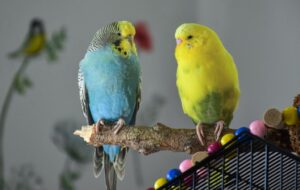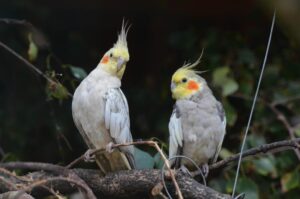India has a long history of admiration for birds, and keeping them as pets is a popular practice. Birds make wonderful companions due to their intelligence, affectionate nature, and ability to interact with humans. Their playful demeanor and ease of care make them a preferred choice for many households.
Legal Aspects of Keeping Pet Birds in India
As per the Wildlife Protection Act of India, it is illegal to keep native wild birds as pets. Any person found in possession of such birds must release them into their natural habitat or hand them over to the forest department. However, exotic birds like budgerigars, cockatoos, and lovebirds can be legally kept as pets. While many people keep parrots, mynas, and finches as pets, capturing and trading them from the wild is unlawful in India.
Choosing the Right Pet Bird in India
Selecting a pet bird isn’t as simple as picking one you find attractive. Strict wildlife laws regulate which birds can be kept as pets. It is important to avoid choosing endangered or native Indian species to comply with legal norms.
Benefits of Having a Pet Bird
Keeping a bird as a pet offers several advantages:
- Stress Relief: In today’s fast-paced world, stress is inevitable. Spending time with a pet bird, whether through play or conversation, can be a soothing and joyful experience.
- Great Companionship: Birds make excellent pets for people of all ages, including those living alone. They enjoy interaction and can even learn to mimic human speech.
- Enhances Empathy: Research suggests that owning a pet bird fosters emotional intelligence, particularly in children, by teaching them compassion and responsibility.
- Encourages Social Interaction: Being a bird owner may lead you to connect with fellow enthusiasts, creating opportunities for socialization and shared learning.
- Low Maintenance: Unlike dogs, birds do not require outdoor walks. Many smaller birds adapt well to compact living spaces, making them ideal for apartment dwellers.
- Cost-Effective Care: While birds require regular veterinary check-ups, they generally do not need vaccinations like other pets. Their diet is also more affordable compared to dogs and cats.
- Highly Intelligent: Birds possess remarkable cognitive abilities and can be trained to perform tricks, recognize their owners, and even mimic words.
- Perfect for First-Time Pet Owners: Birds easily integrate into family life, teaching children the value of responsibility in pet care.
- Loyalty and Affection: Hand-raised birds form strong bonds with their human caregivers and display sociable, affectionate behavior.
- Variety of Choices: Birds come in a wide range of colors, sizes, and temperaments, allowing potential owners to choose one that best fits their lifestyle.
Things to Consider Before Getting a Pet Bird
While birds make wonderful pets, there are some challenges to keep in mind:
- Birds can be noisy, especially vocal species.
- They can create messes with feathers, food, and droppings.
- Birds are natural fliers and may escape if not handled carefully.
- Many birds require social interaction and can become lonely if kept alone.
- Owning a bird is a long-term commitment, as some species live for decades.
- Not all birds can mimic speech; expectations should be realistic.
- Birds and other household pets (like cats or dogs) may not always get along, requiring supervision during interactions.
Best Pet Birds for Beginners in India
One of the best choices for beginners is the Zebra Finch.
Zebra Finch as a Pet
- Adult Size: Up to 4 inches
- Lifespan: 2 – 3 years
- Breeding Difficulty: Easy
- Care Level: Beginner-friendly
With their gentle nature and ease of care, zebra finches are a great option for first-time bird owners. They require minimal space, adapt well to captive environments, and are a joy to watch and interact with.
Understanding Zebra Finches: Origin and Characteristics
Zebra finches are native to central Australia and Indonesia, typically found in grasslands and forested areas near water sources. Their name is derived from the zebra-like stripes across their neck, chest, and their distinctive black and white striped tail. Although small in size, they are highly active and require ample space to move around.
They are naturally social birds and prefer living in flocks. If keeping them as pets, it is ideal to have at least two pairs. As they breed easily, those who do not want baby finches should keep either all males or all females. Even though they enjoy the company of their kind, they do not bond closely with humans and do not like to be handled.
Zebra finches produce soft, pleasant chirps, making them suitable for apartment living.
Distinguishing Between Male and Female Zebra Finches
- Male Zebra Finches: Typically grey in color with a distinctive black teardrop marking near their eyes, bright red cheek patches, and deep red beaks.
- Female Zebra Finches: More muted in color, with paler orange beaks.
- Color Mutations: Zebra finches can be found in different variations, including pied, fawn, cream, and white.
Caring for Zebra Finches
Despite their small size, finches are highly active and require plenty of space for flying. A large, horizontal cage with multiple perches at different heights is ideal. Unlike parrots, finches do not crave human interaction but thrive in the company of their flock.
Their diet should consist of:
- A mixture of seeds, pellets, fresh fruits, and vegetables
- Sprouted seeds, egg meal, and cuttlefish bone/mineral blocks for calcium intake
- Plenty of fresh, clean water
Store-bought finches may initially be reluctant to eat anything beyond seeds, but gradual introduction to a variety of foods is recommended.
Keeping the Cage Clean and Preventing Mites
Regular cleaning of the cage is essential. Remove stale food and clean perches frequently. Zebra finches are prone to mites, so providing a shallow water bowl for bathing helps prevent infestations. If a bird appears unwell, it is usually best to keep it within the cage rather than isolating it, as finches are highly social and may become stressed without their flock.
Breeding Behavior of Zebra Finches
Zebra finches are easy to breed, requiring only a nesting basket and nesting material. They become ready to breed at around 8 to 10 months. However, frequent breeding can exhaust parent birds, sometimes leading to premature deaths, so providing periodic breeding breaks is necessary.
Both parent finches and their chicks benefit from high-protein egg food, which can be store-bought or homemade. If breeding finches, it is advisable to exchange birds with pet stores to avoid inbreeding.
Budgerigars (Budgies) as Pets
For those considering an alternative pet bird, budgerigars are another excellent choice.
- Adult Size: 6 – 7.5 inches (18-20 cm)
- Lifespan: 5 – 8 years
- Breeding: Easy
- Care Level: Beginner-friendly
A male and female Zebra Finch
Budgies make colourful delightful pets.
Budgerigars (Budgies): Origin and Characteristics
Budgies, also known as Budgerigars or Parakeets, originate from Australia. They are among the most popular pet birds globally due to their intelligence, playful nature, and ability to mimic human speech.
There are two types of budgies:
- Wild Budgies – Naturally green with yellow heads.
- English Budgies – Selectively bred for size and color variety, they are larger and come in multiple hues.
Budgies are gentle, friendly, and highly interactive, making them easy to train and bond with.
How to Identify Male and Female Budgies
- The cere (fleshy area above the beak) helps determine gender.
- Males have a bright blue cere.
- Females develop a brownish cere, especially during the breeding season.
- Gender differences become evident when they reach about 6-7 months old.
Caring for Budgies
Although budgies don’t require excessive space, they need room to fly and exercise. A large cage with perches, toys, and space to explore is ideal.
Their diet should include:
- Seeds, sprouted seeds, fruits, vegetables, and leafy greens
- Mineral blocks or cuttlefish bone for calcium intake
- Pellets to maintain a balanced diet
Proper diet and exercise help prevent obesity and liver problems in budgies.
Breeding Behavior of Budgies
Budgies breed quite easily. Mating leads to egg-laying within 8-10 days. A nesting box with a concave bottom is essential for successful hatching. Clutches typically contain 4-7 eggs, with chicks emerging in about six weeks. Both parents participate in feeding the chicks.
Lovebirds as Pets
- Size: 6 – 7 inches
- Lifespan: 15+ years with proper care
- Breeding: Easy
- Care Level: Beginner-friendly
Lovebirds, kept together, become inseparable
Best Pet Birds for Beginners in India
*Some of the most beginner-friendly birds include *Zebra Finches, Budgerigars (Budgies), and Lovebirds.
Lovebirds: Origin and Characteristics
Lovebirds are native to Africa and Madagascar and are well known for the deep bonds they form with their mates. Because of their compact size, they are often referred to as pocket parrots. One distinguishing feature that sets them apart from budgerigars is their short, rounded tails and stockier build.
Lovebirds display a wide variety of colors, from vibrant peach and teal to white and green. Typically, their head and facial feathers are more vividly colored than the rest of their body.
Behavior and Personality
Lovebirds are active, inquisitive, and highly social. They enjoy interacting with humans and fellow birds, making them fun and entertaining pets. However, they require regular handling and attention from an early age to develop a friendly nature. If left unattended for long periods, they may develop territorial or nippy behavior.
Unlike some other parrots, lovebirds are not known for their ability to mimic speech, though they enjoy chattering and chirping throughout the day.
How to Identify Male and Female Lovebirds
Determining the gender of a lovebird can be challenging. Unlike other bird species, males and females look very similar, though in some cases, females may have slightly muted coloring.
To accurately determine gender, consider the following methods:
- DNA Testing: A veterinarian can conduct a DNA test for precise identification.
- Pelvic Bone Check: Females generally have a wider gap between the pelvic bones, but this is more noticeable only after they have laid eggs.
- Behavioral Observation: Female lovebirds are more likely to engage in nesting behavior, such as tearing up materials in the cage to create a nest.
Social Nature of Lovebirds
When kept in pairs, lovebirds develop strong emotional bonds, often becoming inseparable regardless of gender. If you plan to keep a single lovebird, be prepared to provide daily interaction and mental stimulation to prevent loneliness.
Caring for Lovebirds
Lovebirds are primarily seed eaters in the wild, but in captivity, they thrive on a balanced diet that includes:
- A mix of seeds, pellets, fresh fruits, and vegetables
- Cuttlefish bone or mineral blocks for calcium
- Sprouted seeds for additional nutrition
- Clean, fresh water at all times
To keep lovebirds engaged, provide a spacious horizontal cage rather than a tall one, as they prefer flying across rather than vertically. Plenty of toys, perches, and chewable items are necessary to keep them entertained and prevent boredom.
If allowed to roam freely in the house, ensure a safe environment to prevent accidents, as lovebirds are highly curious and may get into mischief.
Breeding Behavior of Lovebirds
Breeding lovebirds is relatively simple. Once a male and female pair is formed, they will soon begin mating. Provide a nesting box with shreddable nesting materials such as paper, grass, or sawdust.
Females typically lay 4 to 8 eggs per clutch, and the incubation period lasts around 23 days. The parents actively care for the chicks, and hand-rearing young lovebirds from about two weeks of age can result in birds that are more accustomed to human interaction.
Chicks generally become independent by 8 weeks of age, and proper socialization at this stage ensures they grow into well-adjusted pets.
Cockatiels as pets
- Size of adult: 12 inches
- Life span:15 to 20 years
- Breeding: Easy
- Care level: Beginner
Cockatiels are intelligent birds that learn to mimic common household sounds
Origin & Characteristics of Cockatiels
Cockatiels are native to Australia, but now they are available in most parts of the world. Cockatiels are small parrots with a variety of colour patterns, head crest and mimicking sounds. They are the smallest from the cockatoo family and exhibit many of the same features and habits as the larger bird.
Some common variations are albino, lutino, pied, pearl, laced or opaline, cinnamon, fawn or Isabelle and silver. There are other mutations including emerald, creamface, pastelface, whiteface and yellow cheek cockatiels.
Cockatiels can be gentle, affectionate and have friendly personalities. Cockatiels can also be curious and feisty. It is best to get these birds when they are young and raise them in a loving environment. These birds are exceptionally intelligent and make great pet birds.
These birds may not talk but they are very sharp and intelligent and may learn to mimic common sounds, such as of a doorbell, phone, alarm clock, etc
Gender Differences between male and female cockatiels
The grey wild-type cockatiels are easily distinguishable. The males have a yellow face while the females are a muted grey almost all over. The males lack spots and barring on the undersides of their wings and tail feathers. Now there are so many mutations and in some cases they are very hard to distinguish.
Also the young males also look like adult females carrying the marking and under their wings. This lose only after they first moult which happens when they are about 10 – 12 months of age.
Caring for Cockatiels
Cockatiels like parrots need a large, spacious cage and toys to play with. Add a number of perches varying in sizes and texture. Make sure the cage is sturdy and secure. These birds are very intelligent.
Cockatiels need a varied diet of seeds, sprouted seeds, fresh fruits and vegetables. Like any other bird they need fresh clean water available and cuttlefish bone or mineral block available to them. They are not over-eaters and unlike other parrots are meagre eaters. To get them to change a seed based diet you require to keep giving them variety. Addition of pellet food will help add variety and nutrition.
The cage needs to be cleaned out regularly and uneaten vegetables and fruits should be removed the same day.
Breeding habits of Cockatiels
A mature male and female will quite easily mate and breed. Provide them with a nice large nesting box and give them nesting material. Within a few days of mating the female will lay eggs and the clutch size can vary from 6 – 8 eggs.
The female needs to be given a lot of fresh fruit and vegetables and a mineral block to help supplement for the loss of the nutrients lost while laying her eggs. If you want the cockatiels to be hand tamed the sooner you start handling them the better. At the age of two weeks you can separate them from their parents and start hand feeding them.
You can alternatively take them out and handle them for 30 minutes each and put them back with their parents. By the 8th week the cockatiels are weaned off and are quite independent.
FAQs
Is it legal to keep birds as pets in India?
In India, as per the Wildlife Protection Act (1972), exotic birds that are not native to India can be kept as pets while the local birds are categorized under wild animals and are illegal to keep as pets. In short, We cannot keep local birds as pets but foreign exotic birds like Cockatoos and Budgerigars can be kept as pets.
Are parrots legal in India?
No, parrots are native birds of India and cannot be kept as pets.
Is Love Birds legal in India?
Lovebirds originated in South Africa & Madagascar and are not native to India. They are not covered under the Indian Wildlife Act but are banned from trade in India.
Can we keep Peacock at home in India?
No, since the Peacock is included in the Schedule I species in the Wildlife (Protection) Act and is also the National bird of India, keeping the peacock at home as a pet is illegal in India.
How to make a bird like you and form a bond with you?
Usually, pet birds are easy to connect with their owners, but some may take longer to like you. To form a bond with your pet bird, approach them slowly, use soft speech, and comfort, and offer their favorite treat.
What are the best pet birds for beginners in India?
You can consider finches or canaries if you have no experience with birds before.
What is the punishment for keeping illegal birds in India?
If the bird is categorized under Schedule 1 then the accused can be punished with 7 years of imprisonment or a penalty of up to Rs. 25,000 or both.
Do I need a license to own a pet bird in India?
No, you do not need a license to own a pet bird in India. However, if you plan to sell or breed birds, you may require a license from the local authorities.
What are some common pet bird species in India?
Some common pet bird species in India include budgerigars (also known as parakeets), cockatiels, lovebirds, African grey parrots, and macaws.
Can I keep a wild bird as a pet in India?
No, it is illegal to keep free wild birds such as parrots and pigeons as pets in India without the required permits and licenses.
Can I import pet birds into India?
Yes, it is possible to import pet birds into India, but you will need to follow the procedures and requirements set by the Indian government. Importing certain bird species may also require additional permits and licenses.
What should I do if I find a lost or injured bird in India?
If you find a lost or injured bird in India, it is best to contact local animal welfare organizations or bird rehabilitation centers for assistance. It is illegal to keep wild birds as pets without the proper permits and licenses, and attempting to care for them without the necessary knowledge and experience can be harmful to the bird.
Compiled & Shared by- Team, LITD (Livestock Institute of Training & Development)
Image-Courtesy-Google
Reference-On Request.







